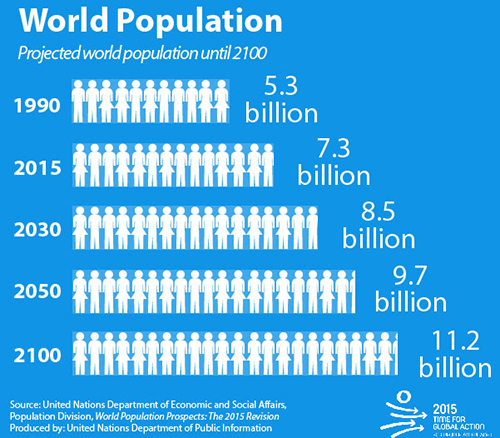Our growing population
In 1950, five years after the founding of the United Nations, world population was estimated at around 2.6 billion people. It reached 5 billion in 1987and 6 billion in 1999. In October 2011, the global population was estimated to be 7 billion. A global movement "7 Billion Actions" was launched to mark this milestone. The world’s population is expected to increase by 2 billion persons in the next 30 years, from 7.7 billion currently to 9.7 billion in 2050 and could peak at nearly 11 billion around 2100.
This dramatic growth has been driven largely by increasing numbers of people surviving to reproductive age, and has been accompanied by major changes in fertility rates, increasing urbanization and accelerating migration. These trends will have far-reaching implications for generations to come.
China and India: most populated countries
Sixty-one per cent of the global population lives in Asia (4.7 billion), 17 per cent in Africa (1.3 billion), 10 per cent in Europe (750 million), 8 per cent in Latin America and the Caribbean (650 million), and the remaining 5 per cent in Northern America (370 million) and Oceania (43 million). China (1.44 billion) and India (1.39 billion) remain the two largest countries of the world, both with more than 1 billion people, representing 19 and 18 per cent of the world’s population, respectively. Around 2027, India is projected to overtake China as the world’s most populous country, while China’s population is projected to decrease by 31.4 million, or around 2.2 per cent, between 2019 and 2050. (Source: World Population Prospects 2019)
The world in 2100
The world population is projected to reach 8.5 billion in 2030, and to increase further to 9.7 billion in 2050 and 11.2 billion by 2100. As with any type of projection, there is a degree of uncertainty surrounding these latest population projections. These figures are based on the medium projection variant, which assumes a decline of fertility for countries where large families are still prevalent, as well as a slight increase of fertility in several countries with fewer than two children per woman on average. Survival prospects are also projected to improve in all countries.
Africa: fastest growing continent
More than half of global population growth between now and 2050 is expected to occur in Africa. Africa has the highest rate of population growth among major areas. The population of sub-Saharan Africa is projected to double by 2050. A rapid population increase in Africa is anticipated even if there is a substantial reduction of fertility levels in the near future. Regardless of the uncertainty surrounding future trends in fertility in Africa, the large number of young people currently on the continent, who will reach adulthood in the coming years and have children of their own, ensures that the region will play a central role in shaping the size and distribution of the world’s population over the coming decades.
Shrinking population in Europe
In sharp contrast, the populations of 55 countries or areas in the world are expected to decrease by 2050, of which 26 may see a reduction of at least ten per cent. Several countries are expected to see their populations decline by more than 15 per cent by 2050, including Bosnia and Herzegovina, Bulgaria, Croatia, Hungary, Japan, Latvia, Lithuania, Republic of Moldova, Romania, Serbia, and Ukraine. Fertility in all European countries is now below the level required for full replacement of the population in the long run (around 2.1 children per woman), and in the majority of cases, fertility has been below the replacement level for several decades.
Factors influencing the population growth
-
Fertility rates
Future population growth is highly dependent on the path that future fertility will take. According to the World Population Prospects (2019 Revision), global fertility is projected to fall from 2.5 children per woman in 2019 to 2.2 in 2050.
-
Increasing longevity
Overall, significant gains in life expectancy have been achieved in recent years. Globally, life expectancy at birth is expected to rise from 72.6 years in 2019 to 77.1 years in 2050. While considerable progress has been made in closing the longevity differential between countries, large gaps remain. In 2019, life expectancy at birth in the least developed countries lags 7.4 years behind the global average, due largely to persistently high levels of child and maternal mortality, as well as violence, conflict and the continuing impact of the HIV epidemic.
-
International migration
International migration is a much smaller component of population change than births or deaths. However, in some countries and areas the impact of migration on population size is significant, namely in countries that send or receive large numbers of economic migrants and those affected by refugee flows. Between 2010 and 2020, fourteen countries or areas will see a net inflow of more than one million migrants, while ten countries will see a net outflow of similar magnitude.
United Nations role in population issues
UN Population Division
The United Nations system has long been involved in addressing these complex and interrelated issues – notably, through the work of the UN Population Fund (UNFPA) and the UN Population Division.
The Population Division pulls together information on such issues as international migration and development, urbanization, world population prospects and policies, and marriage and fertility statistics. It supports UN bodies such as the Commission on Population and Development, and supports implementation of the Programme of Action adopted by the 1994 International Conference on Population and Development (IPCD).
The Population Division prepares the official United Nations demographic estimates and projections for all countries and areas of the world, helps States build capacity to formulate population policies, and enhances coordination of related UN system activities through its participation in the Committee for the Coordination of Statistical Activities.
UN Population Fund
The UN Population Fund (UNFPA) started operations in 1969 to assume a leading role within the UN system in promoting population programmes, based on the human right of individuals and couples to freely determine the size of their families. At the International Conference on Population and Development (Cairo, 1994), its mandate was fleshed out in greater detail, to give more emphasis to the gender and human rights dimensions of population issues, and UNFPA was given the lead role in helping countries carry out the Conference’s Programme of Action. The three key areas of the UNFPA mandate are reproductive health, gender equality, and population and development.
World Population Day is observed annually on 11 July. It marks the date, in 1987, when the world’s population hit the 5 billion mark.
Resources:


